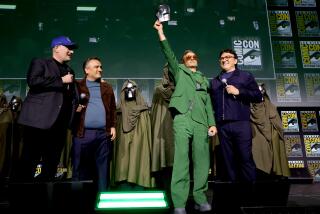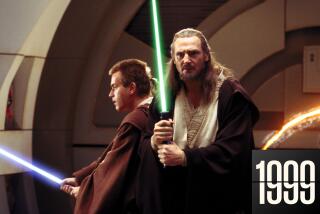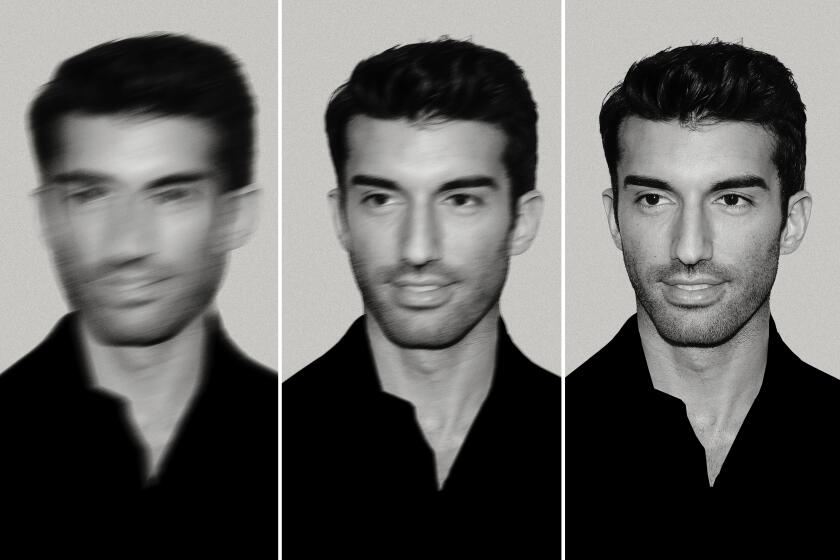It’s a shade more real
- Share via
When Marvel and Universal studios decided to reboot the Hulk just a few years after director Ang Lee brought the mean, green comic-book creature to multiplexes, they quite literally went back to the drawing board. Director Louis Leterrier’s $150-million “The Incredible Hulk” has involved not only a tonal overhaul -- specifically, scrapping Lee’s psychodrama in favor of fugitive suspense recalling the Lou Ferrigno TV show -- but also, just as crucially, giving the character a complete visual makeover.
So while Edward Norton might be taking over as gamma-irradiated scientist Bruce Banner, he’s actually only the second most prominent new face on the Hulkscape. The new man-monster, created by lead digital effects house Rhythm & Hues -- with a look markedly different from the ’03 model designed by effects giant Industrial Light & Magic -- ranks first.
“Very early on, we tried to identify what was wrong with the first movie,” says Leterrier, a Frenchman who made an impression on Marvel with his work on the “Transporter” movies. “The story was a little too dark. But visually, it was the absolute opposite, with a Day-Glo, chubby Hulk that looked like a Buddha on steroids. The fundamental design was just wrong.”
“The Hulk almost had the proportions of a toddler,” says Kevin Feige, Marvel production presidentand an executive producer on Lee’s film. “And yet his size was so large, there was always a great physical distance between him and any human characters, making it more like a relationship with King Kong than this hulking man. It just didn’t connect.”
In fact, that was the case from its first commercial -- during the Super Bowl -- onward, as fans ridiculed the visuals for Lee’s Hulk, letting up a bit only when the movie finally opened. But the film’s heavily Freudian story line became an equally powerful rant magnet. Despite a reported $20-million worth of late-game effects bolstering, the $137-million film earned $132 million in theaters.
But Marvel was determined to try again -- and could, thanks to a $525-million financing deal allowing the company to bankroll its own movies rather than licensing characters to Universal and other studios.
Starting from scratch, Rhythm & Hues did some of its earliest conceptualizing not with some Hulk-size mega-server but just a printer and a green toner cartridge. A 9-foot paper template of the Hulk was output and slapped on the wall of a production office for a few weeks to give the crew a practical feel for how other characters would relate to him physically. (In Lee’s movie, the character’s size changed randomly with his mood swings, to much criticism.)
Of course, effects artists also take on more involved research, trying to reconcile Leterrier’s vision of a ripped Hulk -- “remember that poster of Bruce Lee where he’s super-flexed, and you see all the striation?” the director says -- with actual anatomy and physics. Bodybuilders were the reference models, but the resulting digital composite had a flexibility deliberately at odds with their pumped-up muscle mass, and endoskeletal extrapolations that lent new meaning to the term “big-boned.”
Skin tone was another primary focus, as animators studiously considered, yes, what it would mean to be someone with green blood coursing through his veins. Their determination: The “meat” would be darker as a result, not brighter. Accordingly, their Hulk appears olive in most scenes and, fleetingly, almost slate gray. “We wanted to incorporate him more into our environment, to make him feel like he’s right there and you could touch him,” says visual effects supervisor Kurt Williams, whose team used software engineered for the fantasy menagerie of “The Golden Compass” as a springboard for rendering the Hulk. “We needed to approach him like a CG [computer graphics] human, not a creature.”
While the filmmakers opted to base the Hulk’s features on the comics rather than Norton’s appearance, they did want to incorporate the actor’s mannerisms. “We wanted audiences to be able to read more of Bruce Banner, more emotion,” Williams says. One tool for the job was a cutting-edge motion-capture system that employs phosphorescent face paint and strobe lighting to digitally grab even the most subtle facial movement.
Still, for all the added finessing that can be done five years on, Hulk 2.0’s unveiling was hardly an unqualified success. As trailers rolled out, the old criticisms about the character’s lack of photo-realism once again rang out.
The well-publicized controversy surrounding Norton’s beef with Marvel over the film’s pacing and final cut was the one thing that managed to change the subject. Feige puts a positive spin on reaction to the early footage, insisting, “The argument isn’t what it was on the first movie -- ‘He doesn’t look good, he’s too bright, he’s got a beer belly.’ Now it’s ‘The gleam on his shoulder looks a little plastic-y.’ That’s a huge victory.”
The buzz got better as the movie began screening for review, with a number of fan website “spies” conceding that the effects, while not completely immersing, do look polished and are carried well by the brisk plotline. To tap the comic Hulk’s heroism and to place him in genuine jeopardy, the story pits him against the Abomination, a creature played by Tim Roth in human form. In Leterrier’s ideal cinemonde, the film will offer sufficient action -- including “the biggest bar fight in movie history, with New York as the bar” -- that fans will stop micro-analyzing and start cheering.
But however the finished product goes over, the battle of perception will have been all uphill for the filmmakers. So did Williams think twice about signing on? “Quite honestly, I don’t think we looked back a lot,” he says. “I don’t blame people for not accepting our Hulk right away. Any time you present something new that’s been previously established in people’s minds, it takes a little bit for them to look at it and say, ‘Yes, that’s better. That’s the Hulk from the comics.’ ”
More to Read
Only good movies
Get the Indie Focus newsletter, Mark Olsen's weekly guide to the world of cinema.
You may occasionally receive promotional content from the Los Angeles Times.










